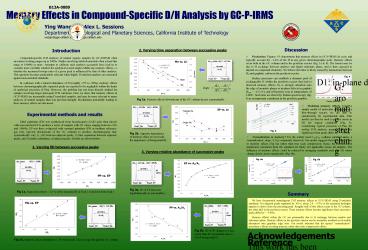Memory Effects in CompoundSpecific DH Analysis by GCPIRMS - PowerPoint PPT Presentation
1 / 1
Title:
Memory Effects in CompoundSpecific DH Analysis by GCPIRMS
Description:
Memory Effects in Compound-Specific D/H Analysis by GC-P-IRMS. Ying Wang and Alex L. Sessions ... Department of Geological and Planetary Sciences, California ... – PowerPoint PPT presentation
Number of Views:22
Avg rating:3.0/5.0
Title: Memory Effects in CompoundSpecific DH Analysis by GCPIRMS
1
B13A-0889
Memory Effects in Compound-Specific D/H Analysis
by GC-P-IRMS
Ying Wang and Alex L. Sessions Department of
Geological and Planetary Sciences, California
Institute of Technology ywjojo_at_gps.caltech.edu,
als_at_gps.caltech.edu
Discussion
Introduction
2. Varying time separation between successive
peaks
Compound-specific D/H analyses of natural
organic samples by GC-P-IRMS often encounter
working ranges up to 300. Studies involving
labeled materials often extend this range to
1000 or more. Attempts to calibrate such
analyses accurately have lead us to consider more
carefully whether the analytical system might
exhibit any memory effects, i.e. whether the
measured isotope ratio of a given peak is
influenced by that of other analytes. This
question becomes particularly relevant when
highly D-enriched analytes are measured against
non-enriched standards. In n-alkanes with a
natural abundance of D (roughly -275 to -50),
memory effects between chromatographically
separated peaks are reported to be negligible
within the limits of analytical precision (2-5).
However, the problem has not been directly
studied for samples involving larger inter-peak
D/H variations. Here we show that memory effects
in GC-P-IRMS are measurable using D-enriched
samples, and may be more relevant to many
analyses of natural samples than was previous
thought. Mechanisms potentially leading to these
memory effects are discussed.
- Mechanism. Figures 1-3 demonstrate that memory
effects in GC-P-IRMS do exist, and typically
account for 1-4 of the H in any given
chromatographic peak. Memory effects occur both
in the GC column and in the pyrolysis reactor
(Fig. 1a b). The former may be due to H
exchange between analytes and liquid stationary
phase, and is thus expected to depend on compound
chemistry. We believe the latter is likely caused
by interactions between H2 and graphitic carbon
in the pyrolysis reactor.
Me vs. ?t
Fig. 4
Surface processes can establish a dynamic pool of
exchangeable H within the pyrolysis reactor that
lead to observed memory effects. H2 is strongly
adsorbed onto the edge of aromatic planes or
in-plane defects in graphite (Eads gt 4.5 eV),
and will persist even at temperatures of 1440C.
Such sites are shown by Raman spectroscopy (fig.
4) as an important constituent in the pyrolytic
graphite.
D1 in-plane defects
slope
G aromatic stretching
dD2
Fig 2a. Memory effects downstream of the GC
column decays exponentially.
Raman Shift (cm-1)
- Modeling memory effects. Using a simple model of
molecular adsorption in a flow-through reactor,
we are able to satisfactorily fit experimental
data. This model can then be used to predict
errors in dD for typical conditions (Fig. 5).
Considering typical precision (2-5) for on-line
D/H analysis, memory effects are significant when
peaks differ by gt 100.
EP vs. ?t
Multiple Me
Experimental methods and results
Ethyl palmitate (EP) was synthesized from
hexadecanoic-2,2-d2 acid, then mixed with
non-enriched EP to produce a series of samples
with dD values ranging between -230 and 800. EP
was then co-injected with n-propyl palmitate (PP)
or methane reference gas (Me, injected downstream
of the GC column) to produce chromatograms that
systematically vary 1) DdD between adjacent
peaks, 2) time separation between adjacent peaks,
and 3) relative abundance of adjacent peaks.
Results are shown below.
Single Me
Fig. 5
Fig 2b. Opposite dependence of memory effect on
?t reveals the importance of background H.
- Normalization or memory? For the widely used
C16-C30 n-alkane standard series, a
normalization slope lt1.0 is commonly observed.
Our model suggests that this slope is due to
memory effects (Fig 6a) rather than true scale
compression. Hence the normalization parameters
calculated from the standard are likely not
applicable across all samples. The influence of
memory effects could be reduced by arranging
standards such that dD values change slowly and
systematically (Fig. 6b).
1. Varying dD between successive peaks
3. Varying relative abundance of successive peaks
Fig. 6a
Fig. 6b
EP vs. A2/A1
PP vs. EP
Fig 3a. dD of EP increases logarithmically as
area doubles
Fig 1a. Regression shows 2.4 of the measured H
in Peak 2 is derived from Peak 1
Summary
We have documented unambiguous D/H memory effects
in GC-P-IRMS using D-enriched standards. For
adjacent peaks separated by 100 s, about 2.4
4.7 of the measured hydrogen appears to derive
from the preceding peak. Roughly half of this
effect occurs in the GC column, the other half in
the pyrolysis reactor. These memory effects
become significant when successive peaks differ
by gt 100. Memory effects within the GC are
presumably due to H exchange between analyte and
stationary phase. Memory effects in the pyrolysis
reactor can be accurately modeled as reversible
adsorption onto graphitic edge sites. Our model
indicates that the typical normalization
procedure is likely recording memory, rather than
scale compression effects.
Me vs. EP
PP vs. A2/A1
Fig 3b. dD of PP changes to a less extent than
EP, presumably due to dD of background H
Acknowledgements This work has been supported by
the Petroleum Research Fund of the ACS
(PRF43746-G2) and by the Low Temperature
Geochemistry program at NSF (EAR-0645502). Thanks
are also to Dr. Magnus Erk for helpful
discussions.
Reference Hoinkis E. Journal Of Nuclear
Materials. 1991, 182 93-106. Beyssac O, et al.
Spectrochimica Acta Part A-molecular And
Biomolecular Spectroscopy. 2003, 59 (10)
2267-2276. Schimmelmann A, et al. Geochim.
Cosmochim. Acta. 1999, 63 3751-3766. Sessions
AL, et al. Analytical Chemistry. 2001, 73 (2)
192-199.
Fig 1b. Memory effects diminish to 1.1 when peak
2 does not go through the GC column.































